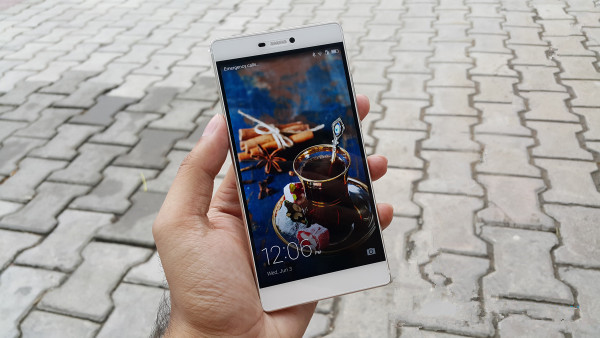How to Enter Huawei P8 Recovery Mode
Huawei P8 comes with Android 5.0 Lollipop, with a custom skin by Huawei on top of it called EMUI. The stock recovery in Huawei P8 is also slightly a customized version instead of having the stock Android recovery that you see in most phones. Huawei P8 stock recovery is touch enabled and is very easy to use. You can use recovery mode for basic maintenance functions such as wiping data, cache and more. This recovery is also used by Huawei to install OTA (over-the-air) updates straight to your phone. In case you install a custom recvoery, that will give you even more advanced functions — such as, creating full Android system backups, wiping each partition separately. Most of all, with a custom recovery you have access to all the custom ROMs and tweaks that we post on this website! You can get into the recovery mode on Huawei P8 using the simple steps we have given below.
Like we mentioned earlier, we have the P8 with us for a while and we will be doing several basic tutorials based on this Android device. Many of you might even have a custom recovery installed, like TWRP or ClockworkMod. This can come really handy because a custom recovery can let you load a custom ROM, create a system wide backup or even format specific partitions — pretty advance stuff can be done to your phone. Let’s move down further and see how can you enter this Recovery Mode on the Huawei P8.
Recovery is something built natively into the Android source code. Almost all phones ship with the stock recovery unlocked and open to the user. Huawei in this case is also very open. You can easily access the recovery partition and there won’t be no damage to your warranty.
Functions available in this mode are primarily maintenance oriented. First function you are able to utilize is the ability to apply an update. Very handy feature indeed. Once a firmware is released by Huawei, it is pushed to all devices. After getting downloaded, phone boots into recovery and flashes the update. Also, if you don’t get the update straight from Huawei, you can download the update zip from the internet and apply that as well. This helps when you are experiencing long delays in updates.
Afterwards, you would notice wipe data or factory reset option along with wipe cache. These are used when you are short on internal space or just want to reset your device. Deleting cache only deletes temporary files while wiping data resets whole of the device leaving no user data behind. If you face some force closes or slow-downs, using these will surely help.
Alongside the benefits it’s our duty to also provide warnings. As this is a crucial partition which has advanced capabilities otherwise not available in the stock system, it can cause prolonged problems. If you are not sure what you are doing, don’t select or implement any of the options. However, measures are in place to reduce errors as much as possible. Validation checks are used before flashing any file so that fatal problems can be avoided.
Custom recoveries are built on top of the stock ones. This means the stock functions will all be there. The difference is the capabilities are enhanced. A popular Custom recovery like ClockWorkMod (CWM) or TWRP (TeamWin Recovery Project) give you the ability to create system wide backups, manually format each partition, fix permissions and much more. Even if you install a custom recovery, accessing it will remain exactly the same.You can enter Recovery Mode on the Huawei P8 using the following three methods:
- by hardware buttons
- by ADB on Windows
- by ADB on Mac OS X
Step 1 – Turn OFF your phone.
Step 2 – Now press and hold the following buttons for a few seconds, all at the same time: Power + Volume Up.
Step 3 – After a few seconds, you should see the Huawei logo first and then enter the Recovery Mode screen on your Huawei P8.
You can now navigate around the recovery mode by taping on options or using your volume and power buttons!Step 1 – Make sure USB drivers / ADB drivers for P8 have been installed and ADB is configured on your computer.
Step 2 – Connect your P8 to your PC with a USB cable and install ADB drivers (if needed).
Step 3 – Navigate to android-sdk-windows\platform-tools directory and open Command Prompt (Shift + Right-click anywhere in the folder > Open Command Prompt).
Step 4 – Type in the following command and press Enter.Step 5 – Your P8 will turn OFF and then boot into the Recovery Mode. Navigate up and down using the volume keys and select with the Power button.
If you need any help regarding this, feel free to drop us a comment below or read: How to backup and rostore Android Device.Step 1 – Make sure USB drivers / ADB drivers for P8 have been installed and ADB is configured on your computer.
Step 2 – Connect your P8 to your Mac with a USB cable.
Step 3 – Now open Terminal app on your Mac and enter the following command and press Enter:/<PATH>/android-sdk-macosx/platform-tools/adb reboot recovery
NOTE: <path> should be the location where your Android SDK is stored. Ifandroid-sdk-macosx is in your main user directory, you can skip the /<PATH>/part from the line given above.
Step 4 – Your P8 will turn OFF and then boot into the Recovery Mode. Navigate up and down using the volume keys and select with the Power button.

 Caroline
Caroline






